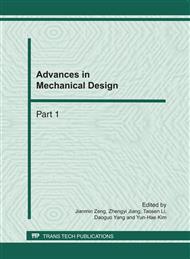[1]
Liu Jianhua, Wang Zhongjuan. The Effect of Fiber Composition and Beating Degree on Breaking Length. Paper and Papermaking, 2004, 3, 45-47.
Google Scholar
[2]
Liu Jianhua, Zhao Muxian. The Effect of Fiber Composition on Breaking Length. Paper and Papermaking, 2003, 1, 40-41.
Google Scholar
[3]
Howard P T. Fiber-water interactions&papermaking[J]. London,U K,II:823-831.
Google Scholar
[4]
A. Rodd,O. Battegaard, Mdium consistency refining-status repeat[J], Paper Technology, 1993, (1-2): 448-450.
Google Scholar
[5]
ByrdM, JameelH, JohnsonW, et a. l Chemical and pulping characteristicsofcorn stalk fractions[C] /NewTechnologies inNon-wood Fiber Pulping and Papermaking, 5thINWFPPC. Guangzhou, China, (2006).
Google Scholar
[6]
JahanM S, IslamM K, ChowdhuryD AN, eta. l Pulping and papermaking properties ofpati (Typha)[J]. IndustrialCrops and ProductsJ., 2007, 26(3): 259.
Google Scholar
[7]
Seth R S. Beating and refining response of some reinforcement pulps[J]. Tappi J., 1999, 82(3): 147.
Google Scholar
[8]
Jujop. Enzymes are breaking into paper[J]. Pulp and Paper Int., 1991, 33(9): 81.
Google Scholar
[9]
Cooper. Process for treating hardwood pulpwith an enzymemixture toreduce vessel elementpicking: US, 5725732[P]. 1998-03-10.
Google Scholar
[10]
Oksanen T, Pere J, Paavilainen L, eta. l Treatmentof recycled kraftpulpswith Trichoderma reesei hemicellulases and cellulases[ J]. Biotechnology, 2000, 78(1): 39.
DOI: 10.1016/s0168-1656(99)00232-1
Google Scholar
[11]
Hill Jr, Walter B, Barclay, et a. l Papermaking processes using enzyme and polymer combinations: US, 693937[P]. 2005-09-06.
Google Scholar
[12]
Bwton StevenW. Low energy thermomechanical pulping process using an enzyme treatmentbetween refining zones: US, 6267841B1[P]. 2001-06-31.
Google Scholar
[13]
FoxT S. Inside a disk refiner[C]. InternationalSymposium on FundamentalConcepts ofRefining. Appleton, (1980).
Google Scholar
[14]
EbelingK. A CriticalReview ofCurrentTheories for the Refining of ChemicalPulps[C]. International Symposium on Fundamental Concepts ofRefining. Appleton, (1980).
Google Scholar
[15]
Leider P J, Nissan A H. Understanding the Disk Refiner: Part 2 mechnical treatment of the fiber[J]. Tapp, i 1977, 60(10): 85.
Google Scholar
[16]
Lumiainen J. Refining Intensity at Low Consistency-Critical Factors[J]. PaperTechnology, 1991, 32(11): 22.
Google Scholar
[17]
HouraniM J. FiberFlocculation in Pulp Suspension Flow[J]. Tapp, I 1988, 71(5): 115; 1998, 71(6): 186.
Google Scholar
[18]
DumontG A, Astrom K J. Wood Chip RefinerControl[J]. Control SystemsMagazine, IEEE, 1988, 8(2): 38.
Google Scholar
[19]
Bruce JAllison, Joe E Clarniello, Patrick JC, et a. l DualAdaptive Control ofChipRefinerMotorLoad[J]. Automatica., 1995, 31(8): 1169.
Google Scholar
[20]
DuHuaijing, GuyA Dumont, Fu Ye. NonlinearControl of aWood Chip Refiner[C]. Proceeding of the 4th IEEE conference on control applications. Albany, (1995).
Google Scholar
[21]
Runklera TA, Gerstorferb E, SchlangcM, eta. l Modelling and optimization of a refining process for fibre board production[J]. ControlEngineering Practice, 2003, 11(11): 1229.
Google Scholar


